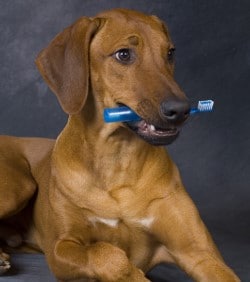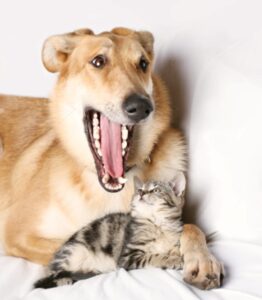 Most pet owners don’t realize…
Most pet owners don’t realize…
Your pet not having their teeth brushed in the first 3 years of their life is equivalent to you not going to the dentist until you are 20! AND…according to the American Veterinary Dental Society, over 80% of dogs and 70% of cats develop periodontal disease before the age of 3 years old. Just like humans, good dental health for pets is critical and may allow you to maximize how long your pet lives. If you’re like me, you want your pet to be around for a LONG time!
Poor dental health has been linked to significant health problems such as kidney, heart, and liver diseases. As the bacteria from the mouth circulates from the gum line into the bloodstream, it will decrease the immune system’s effectiveness.
Most people believe that bad breath is “normal” for pets. However, good “Kitty” or “Doggy” breath is not a given when you own a pet… kind of like that last person you dated. If they have bad breath, they do not have good dental health; this is a universal truth no matter which species.
A LOT of pet parents take their pet’s dental care for granted and don’t honestly pay much attention to it. They might have even had it recommended by their veterinarian, but it was never a convenient time to afford a cleaning. While I completely understand this thinking process, you MUST know – it will only get more expensive the longer you wait!
Now, it gets personal!
So my own mother (sorry Mom!), who has an AMAZING Pet Care Professional and former Veterinary Nurse for a daughter (HA!, a modest one at that), was told, over and over, year after year, with her vet also advising her, to get her schnauzer’s teeth cleaned. It was either TIME or MONEY that continuously came up as the excuse.
FINALLY, when the dog was 9 years old, she booked the appointment. He had to have ELEVEN teeth pulled!!! Dogs only have 42, by the way. The dental work took so long under anesthesia, and her bill was ridiculously expensive! The dental cleaning itself was crazy cheap compared to the cost of all those extractions. That’s not the only lesson here – she was AMAZED at his transformation! He became a completely different dog! He was bouncy and gained a ton of weight because he finally started regularly eating since it didn’t HURT anymore, and he was a puppy again!
Think about the last time you had dental pain – can you imagine not being able to tell anyone about it and LIVING day in and day out with that pain for YEARS??
Our pets experience this when we don’t pay attention!
The bad news is that her dog ended up developing severe kidney failure a few years after, and although he is maintaining well on food and medications, you have to wonder if that also could have been prevented.
So, you might be thinking… Well, Beth, what do you want from me? I can’t possibly brush my pet’s teeth twice a day. I barely do that for my teeth!
Look, let’s start simple. A healthy mouth for your pet will include bubblegum pink colored gums, white teeth, and no bad breath. Seriously, I am only asking for the sun, moon, and stars! At this point, I’m sure you are asking yourself a few questions, and I’m here to answer them!
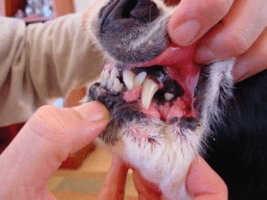 | 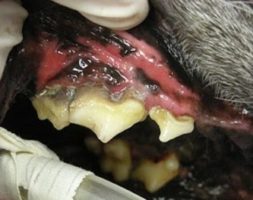 | 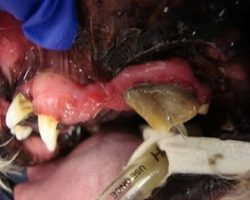 |
How should I start?
If you have never done this for your pet before, it may take a little time for your pet to get used to this. Try using a square gauze piece dipped in peanut butter for your dogs or tuna fish juice for your cats to try and make it a more pleasant experience. Just get them used to you having your finger in their mouth as they lick the scrumptiousness! The point of this step is not to remove any plaque or make significant progress with their dental care. You have to start with trust first.
What should I use?
If your pet does not like something being stuck in its mouth (I mean, who does unless it’s pizza, nachos, or ice cream… none of these I endorse for your pet, by the way), a finger toothbrush might be your best bet. If you are concerned for the safety of your fingers, or it just grosses you out sticking your finger in their mouth, they do make double-ended toothbrushes so you can choose the appropriate size for your pet. Make sure you use pet toothpaste, though – human toothpaste contains ingredients that are dangerous to our pets!
How should I do this?
The best way is to approach your pet is from the back or the side. Just think about the last time your dentist tackled you head-on. If you have a smaller dog or cat, they can be on your lap facing away from you. If you have a larger dog, kneel next to them. Just like your own teeth, make sure you try and get all surfaces. Start from the back inside part of the mouth and work forward, making sure you are getting upper and lower teeth along with the front and back sides of the teeth.
How often should I brush my pet’s teeth?
It may take a little while to get your pet used to their teeth being brushed, but when they get used to it, try and regularly brush their teeth at least once a week. For maximum dental health, though, you would ideally brush their teeth three to five times a week.
When do I know if I have to take them to the vet to get their teeth cleaned?
If you have an older pet and their teeth have never been brushed, they may have already started to develop periodontal disease. If your pet has a loss of appetite, their gums are red and swollen, their gums are receding, or they have loose or missing teeth, these are just some of the signs of periodontal disease, and you should take your pet to your vet to have their teeth examined and cleaned.
 Just start simple!
Just start simple!
Most pet owners hate the cost of dental cleanings, and I’ve heard many of them claim that vets are just using dentals to make more money. I can personally PROMISE you; it is NOT for the money. Most vets would agree that they dislike doing dentals and especially pulling teeth. You know the old saying, “It’s like pulling teeth…” – it was created because pulling teeth is HARD! Vets want their pet parents to do preventative maintenance on their pets. You can avoid or at least PROLONG your pet’s dental cleanings by doing dental care at home. There are many products on the market, and while some MIGHT have some effect on the plaque build-up on the teeth – brushing is still, hands down, the most effective way to remove it!
Just start with the simple goal of brushing your pet’s teeth – once a week. Pick a day! Your wallet and their mouth will thank you!
We teach about dental health and so much more in our Pet CPR & First Aid Courses. To find out when the next one is available in your area, go to our calendar!


